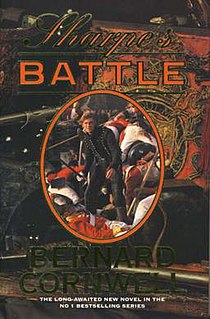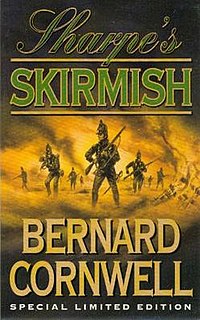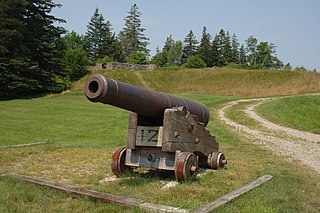
Castine is a town in Hancock County in eastern Maine. The population was 1,366 at the 2010 census. Castine is the home of Maine Maritime Academy, a four-year institution that graduates officers and engineers for the United States Merchant Marine and marine related industries. Approximately 1000 students are enrolled. During the French colonial period, Castine was the southern tip of Acadia and served as the regional capital between 1670 and 1674.

David John Moore Cornwell, better known by his pen name John le Carré, was a British-Irish author, best known for his espionage novels. During the 1950s and 1960s, he worked for both the Security Service (MI5) and the Secret Intelligence Service (MI6). His third novel, The Spy Who Came In from the Cold (1963), became an international best-seller and remains one of his best-known works. According to his son, Nicholas Cornwell, le Carré took Irish citizenship shortly before his death.

Lieutenant-General Sir John Moore, was a British Army general, also known as Moore of Corunna. He is best known for his military training reforms and for his death at the Battle of Corunna, in which he repulsed a French army under Marshal Soult during the Peninsular War. After the war General Sarrazin wrote a French history of the battle, which nonetheless may have been written in light of subsequent events, stating that "Whatever Buonaparte may assert, Soult was most certainly repulsed at Corunna; and the English gained a defensive victory, though dearly purchased with the loss of their brave general Moore, who was alike distinguished for his private virtues, and his military talents."

Bernard Cornwell, is an English author of historical novels and a history of the Waterloo Campaign. He is best known for his novels about Napoleonic Wars rifleman Richard Sharpe. He has also written the Saxon / Last Kingdom stories about King Alfred and the making of England.

The cheval de frise is a defensive obstacle, which existed in a number of forms and were employed in various applications. These included underwater constructions used to prevent the passage of ships or other vessels on rivers, or as anti-cavalry measure consisting of a portable frame covered with many projecting long iron or wooden spikes or spears. They were principally intended as an anti-cavalry obstacle but could also be moved quickly to help block a breach in another barrier. They remained in occasional use until they were replaced by wire obstacles just after the American Civil War. During the Civil War, the Confederates used this type of barrier more often than the Union forces. During World War I, armies used chevaux de frise to temporarily plug gaps in barbed wire. Barbed wire chevaux de frise were used in jungle fighting on the South Pacific islands during World War II.

The Penobscot Expedition was a 44-ship American naval armada during the Revolutionary War assembled by the Provincial Congress of the Province of Massachusetts Bay. The flotilla of 19 warships and 25 support vessels sailed from Boston on July 19, 1779 for the upper Penobscot Bay in the District of Maine carrying an expeditionary force of more than 1,000 American colonial marines and militiamen. Also included was a 100-man artillery detachment under the command of Lt. Colonel Paul Revere.
The Saxon Stories is a historical novel series written by Bernard Cornwell about the birth of England in the ninth and tenth centuries. The protagonist of the series is Uhtred of Bebbanburg, born to a Saxon lord in Northumbria. He is captured and adopted by a Danish warlord. The name of the fictional protagonist comes from the historical Uhtred the Bold; Cornwell is a descendant of this family.

Sharpe's Battle is the twelfth historical novel in the Richard Sharpe series by Bernard Cornwell, first published in 1995. The story is set during the Peninsular War in Spain in 1811.

The 84th Regiment of Foot was a British regiment in the American Revolutionary War that was raised to defend present day Ontario, Quebec and Atlantic Canada from the constant land and sea attacks by American Revolutionaries. The 84th Regiment was also involved in offensive action in the Thirteen Colonies; including North Carolina, South Carolina, Georgia, Virginia and what is now Maine, as well as raids upon Lake Champlain and the Mohawk Valley. The regiment consisted of 2,000 men in twenty companies. The 84th Regiment was raised from Scottish soldiers who had served in the Seven Years' War and stayed in North America. As a result, the 84th Regiment had one of the oldest and most experienced officer corps of any regiment in North America. The Scottish Highland regiments were a key element of the British Army in the American Revolution. The 84th Regiment was clothed, armed and accoutred the same as the Black Watch, with Lieutenant Colonel Allan Maclean commanding the first battalion and Major General John Small of Strathardle commanding the second. The two Battalions operated independently of each other and saw little action together.

The 44th Regiment of Foot was an infantry regiment in the British Army, raised in 1741. Under the Childers Reforms it amalgamated with the 56th Regiment of Foot to form the Essex Regiment in 1881.

Sharpe's Christmas, is a short story collection by historical fiction author Bernard Cornwell which he began conceptualising in 1980s. It contains two stories featuring Cornwell's fictional hero Richard Sharpe. It was published by The Sharpe Appreciation Society in 2003 in order to raise funds for The Bernard and Judy Cornwell Foundation. This novel contains two stories that take place at different times, thus in an interview with the author, the book was left unnumbered in the Sharpe’s series.

Shorncliffe Redoubt is a British Napoleonic earthwork fort. The site is approximately 300 feet by 300 feet and is situated on the Kentish Coast in Sandgate, Kent.

"Sharpe's Skirmish" is a historical short story by Bernard Cornwell in the Richard Sharpe series.

Sharpe's Peril is a British TV film from 2008, usually shown in two parts, which is part of an ITV series based on Bernard Cornwell's historical fiction novels about the English soldier Richard Sharpe during the Napoleonic Wars. Contrary to most parts of the TV series, Sharpe's Peril and the preceding Sharpe's Challenge are not based on one of Cornwell's novels. Both are set in 1817, two years after Sharpe has retired as a farmer in Normandy, so chronologically they come after Sharpe's Waterloo (1815) and before the final novel Sharpe's Devil (1820–1821). In Sharpe's Challenge and Sharpe's Peril, Sharpe and his comrade in arms, Patrick Harper, have been temporarily called out of retirement and asked to go to India.

Alfred Moore was a North Carolina judge who became an associate justice of the Supreme Court of the United States. Moore Square, a park located in the Moore Square Historic District in Raleigh, North Carolina was named in his honor, as was Moore County, established in 1784, also in the state of North Carolina.

Fort George was a palisaded earthwork fort built in 1779 by Great Britain during the American Revolutionary War in Castine, Maine. Located at a high point on the Bagaduce Peninsula, the fort was built as part of an initiative by the British to establish a new colony called New Ireland. It was the principal site of the British defense during the Massachusetts-organized Penobscot Expedition, a disastrous attempt in July and August of 1779 to retake Castine in response to the British move. The British re-occupied Castine in the War of 1812 from September 1814 to April 1815, rebuilding Fort George and establishing smaller forts around it, again creating the New Ireland colony. The remains of the fort, now little more than its earthworks, are part of a state-owned and town-maintained park.
Henry Mowat (1734–1798) was an officer of the Royal Navy commanding ships in northern New England during the American Revolutionary War. He was the son of Captain Patrick Mowat of the post ship HMS Dolphin. He was born in Scotland and went to sea at the age of 18.

New Ireland was a Crown colony of the Kingdom of Great Britain established in modern-day Maine after British forces captured the area during the American Revolutionary War and again during the War of 1812. The colony lasted four years during the Revolution, and eight months during the War of 1812. At the end of each war the British ceded the land to the United States under the terms of the Treaty of Paris and the Treaty of Ghent, respectively.
Bernard Cornwell's career started in 1981 with Sharpe's Eagle. He has been a prolific historical novelist since then having published more than 50 novels.















